Turning up the heat: How Americans prefer to warm up their homes in winter
Solar power becoming a popular choice to heat homes

Most Americans turn to fossil fuels, like natural gas, coal and oil, as a way to heat their homes during the winter months. Still, some renewable energy options have become increasingly popular over the years.
According to the Department of Energy, heating homes uses more energy and costs more for the consumer, but proper maintenance and upgraded equipment can be beneficial.
Here are some of the different ways Americans heat their homes and which are the most popular options in the different regions of the country.
Solar Energy

(Vivint Solar on Unsplash / FOX Weather)
If you live in an area that can get cold in the winter but still receive plenty of sunshine, then a solar heating system may be the way to go.
Solar heating systems work by using energy from the sun to heat a fluid, and then the system delivers the heat directly into your home or can be stored for later use.
And there are a few ways the Department of Energy says solar heat can be used to heat your home. The heated fluid can be used in radiant floor systems, hot water baseboards or radiators, or a central forced-air system to distribute the heat.
Electric Resistance Heating
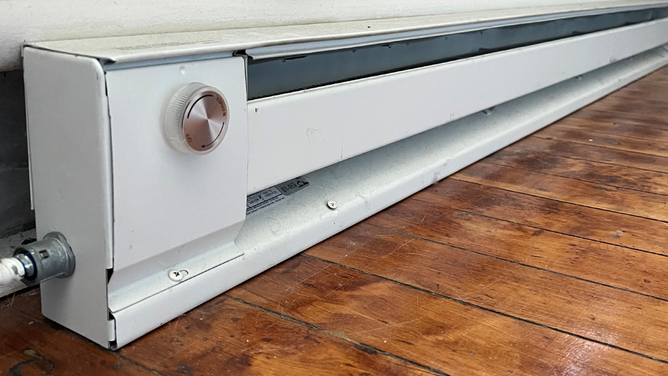
(FOX Weather)
Electric heat is often more expensive in the United States.
"Most electricity is produced from coal, gas or oil generators that convert only about 30 percent of the fuel's energy into electricity," the Department of Energy says on its website.
And because of those generation and transmission losses, it costs more.
The heat from electricity can be delivered with forced-air systems, furnaces or heaters in every room of the home, and that consists of baseboard heaters, wall heaters, a space heater or radiant heat.
Electric furnaces will end up costing you more because it loses heat as its being distributed around your home and because it needs more energy to do so. Large fans from within the furnace blow air over coils and deliver heat into your home.
Baseboard heaters are individually controlled in each room. The units contain electric elements encased in metal pipes. Those pipes are surrounded by aluminum to transfer the heat. As the air inside the heater is warmed, it rises into the room, and colder air is pulled down.
The units are usually always installed under a window. This is because they aim to heat the home's perimeter, where the most significant heat loss occurs.
Electric wall heaters are also an option, and they work by reflecting heat off a reflector behind it into the room, usually with the use of a fan. Those are typically installed in an interior room.
Radiant Floor Heat
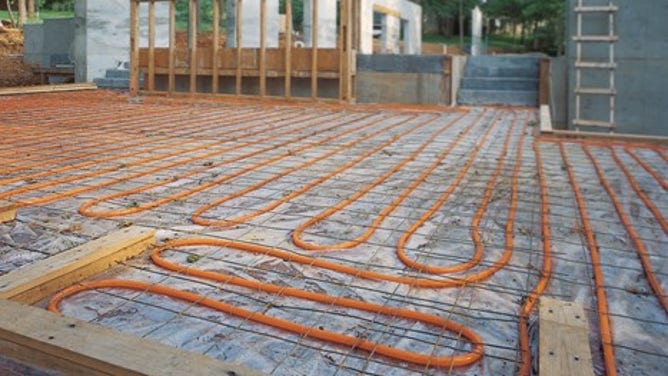
(United States Department of Energy / FOX Weather)
A radiant heating system is used by installing a series of tubes or cables in the floor, wall or ceiling of a home. Air or liquid is then warmed by using electricity or gas or oil boilers, wood-burning boilers, solar energy or a combination of those options.
This option also has some advantages.
"People with allergies often prefer radiant heat because it doesn't distribute allergens as forced air systems can," the Department of Energy said.
Furnaces/Boilers
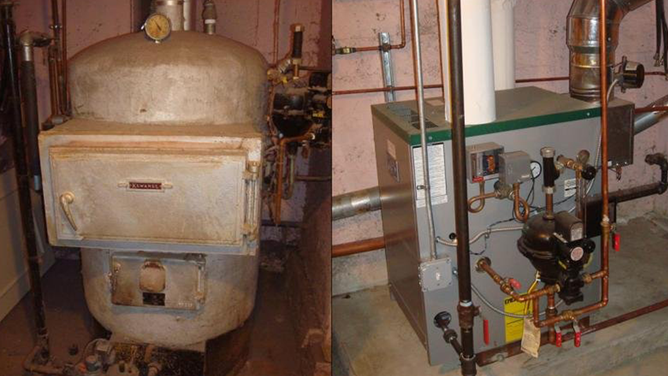
(United States Department of Energy / FOX Weather)
Among the most popular systems in American homes are furnaces or boilers.
Furnaces move heated air through the home using ducts, while boilers heat water and provide hot water or steam to get heat.
Steam can heat radiators, and hot water can heat baseboard radiators or radiant floor systems. Steam boilers can be less energy efficient, but different types can be installed in a home which can help reduce how much energy is needed to operate and lower the cost.
Wood/Pellet Heating

Wood-burning and pellet stoves have come a long way. Today, you can buy one that's more efficient, burns cleaner, and heat large spaces. But it would be best if you chose wisely when installing one. If it's too big, many people will run them at lower temperatures, wasting fuel. If it's too small, you won't get as much heat.
A wood-burning stove or fireplace isn't great for the environment, either. Smoke from burning wood emits pollutants into the air, affecting the health of people inside the home.
And traditional open fireplaces should only be considered for show, not for a primary heat source. This is because fireplaces pull in heated air for combustion, and that precious heat will go right up the chimney.
Pellet stoves are easier to operate than a wood stove or fireplace and can be much more efficient.
The pellets are usually made of wood but can also be made using other organic materials like a nutshell, corn kernels and wood chips.
That usually means they don't produce as much air pollution as a wood-burning stove and are better for heating homes and apartments.
What's the most popular in different regions?
Every 10 years, the United States Census Bureau sends people out to count every person living in the United States, and one of the questions on the census form asks about how a person's home is heated.
That data is then used to analyze the energy needs in local communities and can be used to determine things like future energy demand and the fuels that are available.
According to the most recent census, 48 percent of the country relies on gas for home heating. Coming in second were homes that relied on electricity, which was at 38.9 percent. And only 0.2 percent of homes in the United States rely on solar energy.
But let's break that down even further.
Northeast:
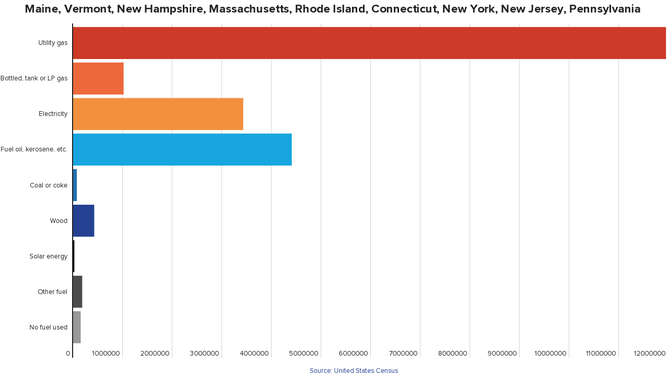
(FOX Weather)
In the Northeast, the most popular choice to heat a home was with the use of gas, followed by oil and electricity.
South:
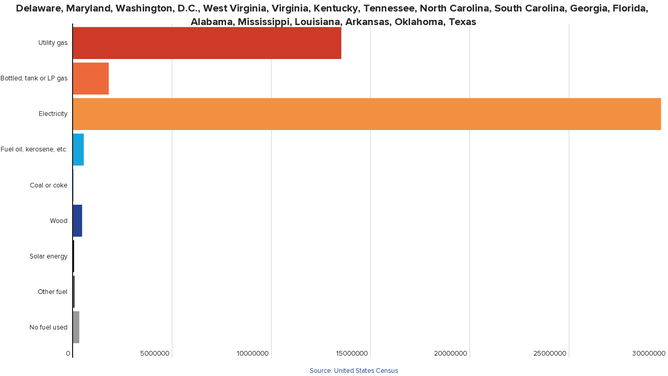
(FOX Weather)
The South changes things up a bit. The most popular way people heat their homes is by using electricity. After that, popular choices include gas, oil and wood.
Midwest:
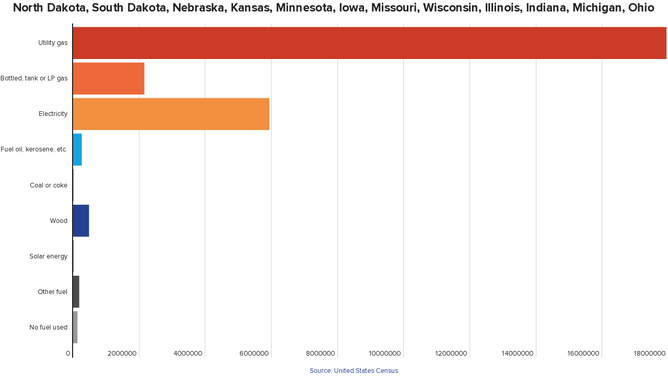
(FOX Weather)
Gas and electricity are the most popular choices in the Midwest, but more people prefer burning wood over the use of oil.
West:
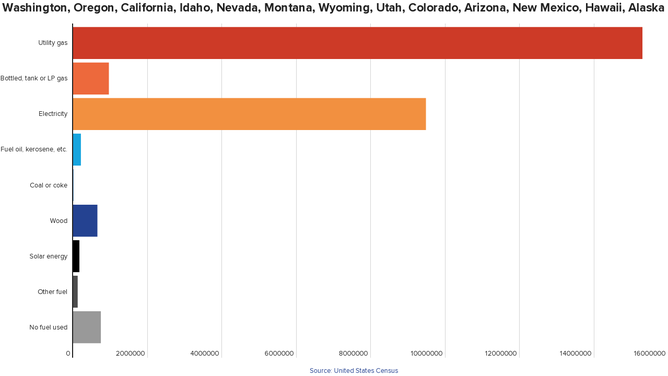
(FOX Weather)
Gas and electricity take the top spots in the West, too. But many people don't use any fuel whatsoever. Most likely because some parts of the area, like Southern California, Arizona and Nevada, remain warm all year. Besides that, wood is the way to go for many homes.